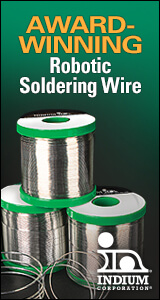|

|
|
| Ask the Experts | |||||||
|
|||||||
|
February 25, 2008 - Updated February 25, 2008 - Originally Posted Acceptable Number of RepairsAre there any guidelines for determining the acceptable number of repairs to a circuit assembly? R. H. |
|||||||
| Expert Panel Responses | |||||||
|
This question has been asked for many many years and my answer has always been the same. In the 60s and 70s, Roger Wild of IBM did some testing of plated through holes to determine the impact of thermal cycling or soldering the holes and found that each time a plated through hole was thermally cycle its time to failure decreased. At that time the total number of thermal excursion a printed circuit board was to be exposed to was set at 5, implying a circuit board could not be exposed to more than 5 thermal cycles. With this guideline, the industry then determined what was considered a thermal cycle. For example in those days the solderable coating was typically a electroplated tin/lead coating which was fused, which was the first thermal cycle, the wave solder was the second and there were three remaining cycles to remove and replace components. With the introduction of Surface Mount in the 80s, along with the introduction of SMOBC, Solder Mask Over Bare Copper and Hot Air Leveling, Hot Air Leveling became the first thermal cycle, the second and third cycle was the reflow of the first and second side of surface mount assembly, which left two cycles left to remove and replace components. With the ability to heat only a section of the boards today to remove and replace components, this concept may be modified somewhat, but experiments should be conducted to verify no damage was created in the laminate materials. Today the laminate materials are different, the copper plating is different, the holes are much smaller, the plating is much thinner, so one has to wonder if today's boards are more robust than those of an earlier vintage. I believe five thermal cycles is still a good guideline to use. I realize BGA components may need to be replaced few times but keep in mind that all the solder joints in proximity to the BGA will be exposed to a large and long thermal cycle and will this cycle impact the long term functionality of the board. As this is your product and your name is on it, I would be very much concern about the long term reliability of this section of the board, as it will expand and contract with every thermal cycle and each one of those cycles will impact the life of the plated through via holes. I just cannot imagine at this point what this will do with blind and buried vias. More experiments needs to be conducted to evaluate this condition and the results should be published for the industry to learn what is happening.
Vice President, Technical Director EPTAC Corporation At EPTAC Corporation, Mr. Lambert oversees content of course offerings, IPC Certification programs and provides customers with expert consultation in electronics manufacturing, including RoHS/WEEE and lead free issues. Leo is also the IPC General Chairman for the Assembly/Joining Process Committee.
Historically speaking the only standard I recall that specified limits for the number of rework, repair, and or modification was MIL-C-28809. Often this standard was contracted specifically for that purpose with additional soldering requirements provided per higher tier standards such as MIL-STD-2000 and the like. 28809 also provided standard repair processes and disposition for requirements considering nonstandard processes.
FSO/Director Training Resources STI Electronics Inc. Mel Parrish is the FSO and Director of Training Materials Operations, Soldering Technology International (STI), in Madison Alabama. Before coming to the STI, Mel was the Training Manager for the Electronic Manufacturing Productivity Facility (EMPF) and President of Manufacturing Technology Training Center Inc. (MTTC) in Ridgecrest, CA. He remains active in industry trade associations and organizations such as IPC, SMTA, and SME.
The other panel members that have already responded are extremely knowledgeable and well respected and expert in this area. I will speak to this from the perspective of a rework and repair facility. The reality is that we see the quality of the board construction can vary quite dramatically. A good quality circuit board can withstand several heat cycles beyond the original assembly process and hold up quite well without issue. This assumes that a properly controlled baking, handling and rework process are followed.
Sales Engineer Circuit Technology Center Mr. Price has been a key member of the team at Circuit Technology Center since 1985. He has vast expertise, experience and understanding of complex circuit board rework, repair and modification operations. He is one of the most knowledgeable experts in this area across the globe.
|
|||||||
| Submit A Comment | |||||||
|
Comments are reviewed prior to posting. You must include your full name to have your comments posted. We will not post your email address. |
|
Free Newsletter Subscription
Circuitnet is built for professionals who bear the responsibility of looking ahead, imagining the future, and preparing for it. Insert Your Email Address |
|

|





